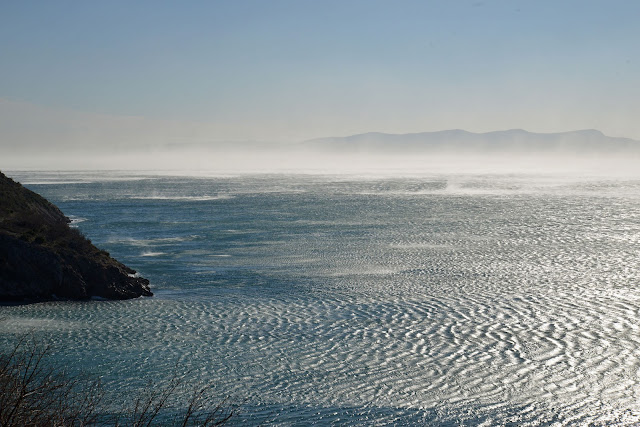In Croatia for two months by now, with renovation of the new house almost completed. Weather was cold in past weeks and we took advantage of a nice sunny forecast over Croatia to explore the coast between Rijeka and Zadar during last weekend. It was sunny, windy and cold when we left Pula. The picture below is the view towards south-east as we start the journey along the coast.
 |
| Typical Bura configuration along the coast |
The weather was fantastic when leaving Pula (by car, not by boat). Just a few questions regarding the heavy cloud load over the mountains on the horizon and the whitish haze over the sea in the distance. Any serious resident in Croatia would have warned us about Bora in this configuration. In fact, the cap on top of the mountains is the sign announcing the Bora, but not much time in advance. In the absence of warning, we discovered what it means by ourselves!
The Bora is a winter katabatic wind, meaning a wind resulting from a mass of cold air spilling over a mountain ridge to fall by gravity in whatever is below. It blows along the east coast of the Adriatic see, but particularly strong along the coast of Croatia, in the Velebit sea, between Senj on the north and Jasenice on the south. This is the location of the 145km long Velebit mountains culminating at 1757 metres from the sea level. When there is a high pressure North-East of the chain of mountain, and a low pressure along the cost, the katabatic cold winds are spilling over the mountains and falling (by gravity, cold air from the mountains being heavier than the light warmer air at sea level) at record speed, often over 100 knots, with a record at more than 150 knots!
The Velebit coast and Velebit mountains
Pag Island below, just few hundred metres from the coast is getting hit by these winds, which destroy everything on their path, explaining why the south-west side of the mountains appears so bright on the google satellite map. No vegetation left, just bare rocks! And the same on the north-east side of the Pag island which receives the wind from the Velebit sea. Not a place where you want to be caught by surprise by the Bora. Hopefully, the Bora is quite unfrequent and weaker in summer.
As we drive along the coast, we stop to take a few pictures. The wind is so strong that it is no longer safe to walk outside of the car as the wind can blow you down the slope quite easily. In fact, even cars are not really safe driving along the coast.
The Bora is very irregular in strength and direction when it reaches the sea level. It gains strength when passing through canyons on its way to the sea, as you can see on the foreground of the picture below. A bit further out, it generates heavy spray limiting drastically he visibility. Not a good idea to be sailing in these circumstances, not always providing warning of their sudden start.
Bora along the Velebit sea shore
Velebit sea under Bora. Estimated Beaufort 9 with gust of 10
Below is the island of Goli Otok that was until 1989 a Yugoslavia political prison and is since deserted. There is no vegetation on the island because of the Bora wind.
The island of Gold Otok
The following day, the Bora was gone. We could nicely explore Zadar in a still very cold weather.
Zadar has a lot to offer, in particular in the old town. It starts with the entry gate in the old town of Zadar.
Zadar old town harbour
Back to the water front is the church of Saint Donatus, the largest pre-romanesque church in Croatia, the construction of which started in the IXth century during the Carolingian period.
The Church of Saint Donatus in Zadar
The Morske Orgulje is an experimental sea organ operated by sea waves blowing air through tubes located underneath a set of large marble steps. Click on the video below to experience it.
Further south, along the E65, there is an interesting "fjord" along the Krka river renowned for its multiple waterfalls. We could not explore because we were late, but the view towards the small city of Skradin and its harbour will certainly be visited by Belisama in the future...

Skadin village from the E65 highway bridge
A view of the old town harbour of Rijeka on the way back to Pula.
Rijeka small boat harbour
The Saint Vitus Rijeka cathedral below was founded in 1638.
On the front wall is a stuck cannon ball with the following inscription: "This fruit was sent to us by England when it wanted to oust the Gauls from here." This refers to the times following the Austerlitz Napoleon victory in 1805, when Napoleon established the Illyrian Republic under the empire. This ended in 1815 with the defeat of Napoleon in Waterloo. This canon ball symbolise the battles that opposed the British and the French during these troubled times.













thank you for the visit! where will you put Bélisama for winters?
ReplyDeleteBelisama will be based in Pula, starting probably only summer 2022 as we plan to have probably in Toulon for the 2021/2022 winter.
Delete